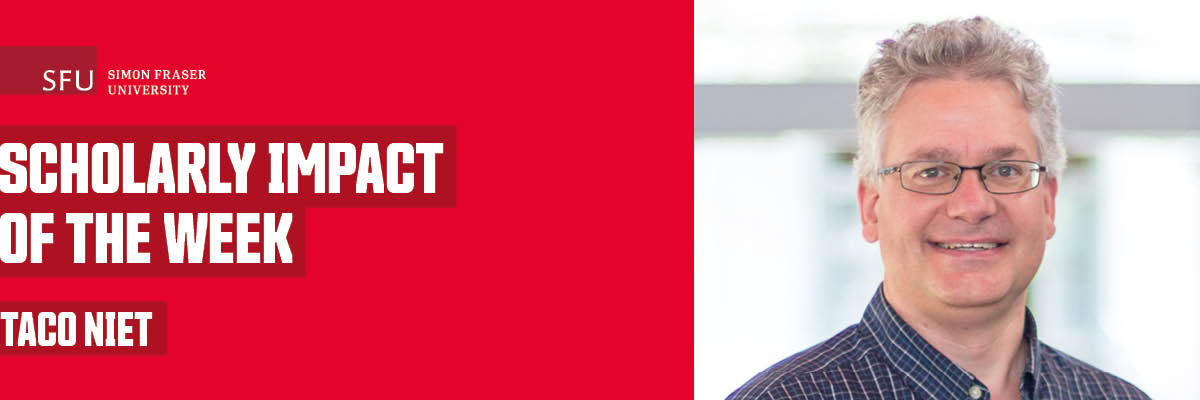
Considering the short timeline to take significant action on climate change, while also safeguarding increasingly pressed natural resources, it is vital to consider the nexus—or interactions—between climate, land, energy and water as a whole. By modelling the nexus interactions, rather than analyzing each system in isolation, researchers can identify synergies and ensure climate change mitigation strategies complement rather than compete with each other.
Simon Fraser University (SFU) sustainable energy engineering professor Taco Niet studies the interconnectedness of the world’s natural resources, with special attention to the effect human beings have on their environments.
His research interests include climate change mitigation and adaption, integration of renewable energy technologies and energy systems modeling. He and his team at the ΔE+ (Delta-E-plus) Research Group collaborate with industry, government and academia on projects that move energy systems towards a more sustainable future. Niet is one of many SFU experts contributing to community-centred climate innovation, while providing insights that policymakers need to make better decisions for human and environmental well-being.
He is also a key member of the international collaboration behind the OSeMOSYS Open-source Energy Modelling System—of which SFU is a partner. OSeMOSYS is a free, open-source energy systems model that can be used to assess long-range energy planning, including integrating traditional and renewable energies. It has been used to develop energy systems models at the global, national, regional and local scale.
A recent application of this model is OSeMOSYS Global, an open-source, open data global electricity system model generator, lead author and SFU Master’s student Trevor Barnes, which was published in Nature Scientific Data.
Niet, Barnes and Master’s student Kumaria Kuling recently expanded on the OSeMOSYS Global model generator to develop a Climate, Land, Energy, Water systems (CLEWs) framework for Canada examining the benefits and trade-offs of using switchgrass—a fast-growing prairie grass—as biofuel. The study considered whether the amount of land and water resources needed would justify its production as an energy source. It was also the first time a Canada-wide CLEWs model had been utilized.
Ultimately, the OSeMOSYS system and CLEWs framework demonstrated that switchgrass biofuels can contribute to low carbon dispatchable electricity, however its production demands the use of land and water resources which might be better utilized for food crop production. The researchers suggest switchgrass energy would be most suitable in applications such as heavy-duty transport that are difficult to decarbonize.
They recommend their findings be used to inform policy development, while the study model can be applied to other countries. The paper, Applying the open-source climate, land, energy, and water systems (CLEWs) model to Canada was recently published in Energy Strategy Reviews.
We spoke with Professor Niet about his research.
The CLEWs paper talks about competing interests for resource use—and the best use for land and other resources. Are there beneficial decarbonization pathways that should be getting more attention?
Most decarbonization pathways are, luckily, getting some good, positive, attention. There are a few interesting food technology pathways that show promise like lab-grown meat and meat-free ‘meat’ products which will be interesting to see develop. Making fast and consistent progress on building out the electricity grid, both to replace existing fossil generation and add new low-carbon renewables and/or nuclear is becoming very urgent since large projects take time to develop and build.
One thing that we all need to be aware of is false hopes—pinning our climate hopes on technologies that lock in emissions. Natural gas (or in British Columbia, Liquified Natural Gas) for power generation is a great example. It requires significant infrastructure upgrades to implement, potentially taking energy and dollars away from more effective climate mitigation pathways. And, fugitive emissions from LNG likely mean that it isn’t actually any better for the climate overall.
How did you become involved in the OSeMOSYS Global project?
In terms of OSeMOSYS Global, this came out of a collaboration between myself, Maarten Brinkerink (at the time with University College Cork) and Abhishek Shivakumar (at the time with Imperial College London/the United Nations). We looked at the available tools and workflows and realized there was some potential for developing a fully open source tool and data workflow for energy analysis since many other tools are proprietary and closed source.
The CLEWs work came out of consulting for the United Nations on their CLEWs capacity building for emerging economies. I helped the UN Department for Economic and Social Affairs (UN DESA) build CLEWs models for emerging economies and then trained in-country representatives on the modelling tools.
Regarding SFU’s unique approach of community-centred climate innovation, you and your research team are working on several collaborations. Why is community-centred collaboration so important?
I think all climate action needs to be community-centred, innovative and focused on climate justice. I was fortunate to be a Researcher in Residence with the Community Engaged Research initiative in 2022 and that helped me connect to other folks with similar interests.
Tell us about guiding and supervising students in the relatively new Sustainable Energy Engineering (SEE) program at SFU. What have you enjoyed most?
I have really enjoyed building up my research group, guiding students in developing their research questions and working on publications like those above. It has been very interesting being part of the SEE program from the start—we are figuring out processes and procedures for our students as we bring them on board so that’s been interesting, both from a supervisory point of view but also as a member of the Graduate Program Committee. I find it very rewarding being the guide for my students’ research and helping them reach their potential.
SFU's Scholarly Impact of the Week series does not reflect the opinions or viewpoints of the university, but those of the scholars. The timing of articles in the series is chosen weeks or months in advance, based on a published set of criteria. Any correspondence with university or world events at the time of publication is purely coincidental.
For more information, please see SFU's Code of Faculty Ethics and Responsibilities and the statement on academic freedom.